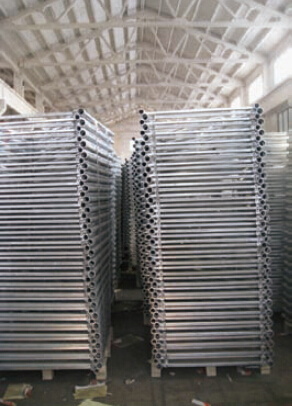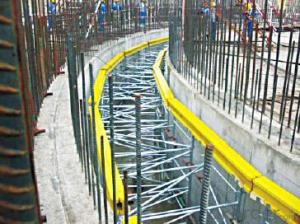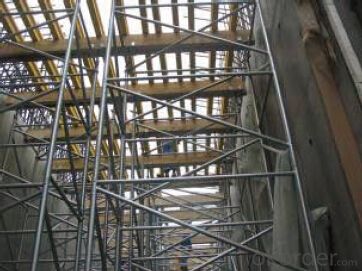Tower scaffolding for Formwork and Scaffolding System
- Loading Port:
- Tianjin
- Payment Terms:
- TT OR LC
- Min Order Qty:
- 50 m²
- Supply Capability:
- 1000 m²/month
OKorder Service Pledge
Quality Product, Order Online Tracking, Timely Delivery
OKorder Financial Service
Credit Rating, Credit Services, Credit Purchasing
You Might Also Like
Tower Scaffolding
Shoring tower is an effective supporting system. It is easy to assemble and dismantlement, and
has excellent stability and bearing capacity. It has been widely used in the construction of industry
& residential buildings , bridges, tunnels and dam project, etc.
Characteristics:
◆ High degree of standardization.
◆ Easy storage and transportation

- Q: Can steel formwork be used for decorative concrete finishes?
- Yes, steel formwork can be used for decorative concrete finishes. It provides sturdy support and precise shaping, allowing for intricate designs and smooth finishes in decorative concrete applications.
- Q: Can steel formwork be used for marine construction projects?
- Marine construction projects can indeed utilize steel formwork. The durability of steel makes it suitable for enduring the challenging conditions of the marine environment, including exposure to saltwater, waves, and corrosive elements. By providing the necessary strength and stability, steel formwork can withstand the forces exerted in marine settings. Its versatility allows it to be utilized in various marine construction applications, such as the construction of seawalls, piers, jetties, and offshore structures. Furthermore, steel formwork offers numerous advantages, including easy assembly and disassembly, reusability, and the ability to create intricate shapes and structures. However, to ensure the long-lasting performance of steel formwork in marine environments, it is crucial to implement proper corrosion protection measures, such as galvanization or the use of anti-corrosive coatings.
- Q: Can steel formwork be used in areas with limited construction space or tight site constraints?
- Yes, steel formwork can be used in areas with limited construction space or tight site constraints. Steel formwork systems are highly versatile and can be customized to fit into small or irregularly shaped spaces. They can be easily adjusted and modified to accommodate different project requirements and site constraints. Additionally, steel formwork offers high strength and durability, allowing for efficient construction even in challenging site conditions.
- Q: How does steel formwork contribute to improved construction site access?
- Steel formwork contributes to improved construction site access in several ways. Firstly, steel formwork is highly durable and reliable, which allows for the creation of robust and stable structures. This means that construction sites can be accessed more easily and safely by workers, as they can confidently navigate the formwork without concerns about its stability or integrity. Secondly, steel formwork is highly versatile and can be customized to fit any project's specific requirements. This flexibility allows for the creation of complex shapes and designs, which can improve access to different areas of the construction site. For example, curved or inclined formwork can be used to create ramps, staircases, or other access points that facilitate movement and navigation around the site. Additionally, steel formwork is known for its high load-bearing capacity, which means that it can support heavy loads and equipment. This is particularly important in construction projects that involve the use of cranes, scaffolding, or other heavy machinery. By providing a sturdy platform, steel formwork ensures that access is maintained even when heavy loads need to be transported across the site. Furthermore, steel formwork is quick and easy to assemble, which can significantly reduce construction time and improve access on site. Its modular design allows for efficient installation and dismantling, meaning that access points can be created or modified as needed in a timely manner. This is particularly beneficial in projects where construction schedules are tight or where the site layout needs to be adapted frequently. In summary, steel formwork contributes to improved construction site access by providing durability and stability, allowing for versatile designs, supporting heavy loads, and enabling quick and easy assembly. These features enhance worker safety, facilitate movement around the site, and help maintain productivity and efficiency in the construction process.
- Q: What are the different types of formwork bracing used with steel formwork?
- There are several types of formwork bracing that can be used with steel formwork. These include: 1. Horizontal Bracing: This type of bracing is used to provide stability and support to the horizontal members of the formwork system. It is typically installed between the vertical supports and helps to prevent any lateral movement or deformation of the formwork. 2. Diagonal Bracing: Diagonal bracing is used to provide additional stability to the formwork by connecting the vertical supports diagonally. This helps to distribute the load evenly and prevent any twisting or buckling of the formwork. 3. Vertical Bracing: Vertical bracing is used to support the vertical members of the formwork system. It is typically installed between the horizontal supports and helps to prevent any vertical movement or deformation of the formwork. 4. Cross Bracing: Cross bracing is a combination of horizontal and diagonal bracing. It is used to provide both lateral and diagonal support to the formwork system. Cross bracing is often used in larger structures or when there is a need for increased stability. 5. Tie Rods: Tie rods are used to connect the formwork panels and provide additional support. They are typically placed at regular intervals along the formwork and are tightened to ensure that the formwork remains in place during the concrete pouring process. Overall, the choice of formwork bracing will depend on the specific requirements of the project, including the size and complexity of the structure, as well as the load-bearing capacity of the formwork system. It is important to carefully design and install the bracing to ensure the safety and stability of the formwork during the construction process.
- Q: Can steel formwork be used for tall structures?
- Yes, steel formwork can be used for tall structures. Steel is a strong and durable material that can withstand the weight and pressure of concrete. It offers the necessary stability and support required for constructing tall buildings and structures. Additionally, steel formwork is versatile, allowing for flexibility in design and construction.
- Q: What are the different steel grades used in steel formwork?
- There are several different steel grades that are commonly used in steel formwork, each with their own specific characteristics and advantages. Some of the most common steel grades used in steel formwork include: 1. Mild Steel (Grade 250): Mild steel is a low carbon steel that is relatively inexpensive and easy to work with. It offers good strength and durability, making it suitable for many construction applications. However, it may not have the same level of resistance to corrosion as other steel grades. 2. High Tensile Steel (Grade 500): High tensile steel is a type of steel that has a higher strength-to-weight ratio compared to mild steel. It offers superior strength and durability, making it suitable for heavy-duty applications. High tensile steel is often used in formwork for structures that require greater load-bearing capacity. 3. Stainless Steel: Stainless steel is a corrosion-resistant alloy that contains a minimum of 10.5% chromium. It offers excellent resistance to corrosion, making it ideal for formwork that will be exposed to harsh environmental conditions or chemicals. Stainless steel also has a high strength-to-weight ratio and is often used in marine and chemical industry applications. 4. Weathering Steel (Grade 350): Weathering steel, also known as corten steel, is a high-strength, low-alloy steel that forms a protective layer of rust when exposed to the elements. This protective layer helps to prevent further corrosion, making it suitable for formwork in outdoor environments. Weathering steel is often used in bridge construction and other infrastructure projects. 5. Galvanized Steel: Galvanized steel is steel that has been coated with zinc to provide protection against corrosion. The zinc coating acts as a barrier, preventing moisture and oxygen from reaching the underlying steel. Galvanized steel formwork is commonly used in concrete construction, as it offers excellent corrosion resistance and durability. Overall, the choice of steel grade for steel formwork will depend on various factors including the specific application, load-bearing requirements, and environmental conditions. It is important to select the appropriate steel grade to ensure the longevity and performance of the formwork system.
- Q: What are the different types of steel used in formwork construction?
- There are several types of steel used in formwork construction, each with their own specific characteristics and applications. 1. Mild Steel: This is the most commonly used type of steel in formwork construction. It is affordable, readily available, and easy to work with. Mild steel is suitable for most formwork applications and offers good strength and durability. 2. High Tensile Steel: This type of steel is stronger than mild steel and has a higher tensile strength, making it ideal for heavy-duty formwork structures. High tensile steel provides enhanced resistance to bending and deformation under heavy loads, making it suitable for large-scale construction projects. 3. Reinforcing Steel: Reinforcing steel, also known as rebar, is used in formwork construction to reinforce concrete structures. It is typically made of carbon steel and is available in various grades and sizes. Reinforcing steel is used to increase the tensile strength of concrete and improve its resistance to cracking and structural failure. 4. Stainless Steel: Stainless steel is used in formwork construction when corrosion resistance is a primary concern. It is particularly suitable for formwork exposed to harsh environmental conditions or in contact with corrosive materials. Stainless steel offers excellent resistance to corrosion, making it a durable and long-lasting option for formwork construction. 5. Alloy Steel: Alloy steel is a type of steel that is mixed with other elements to enhance its properties. It is commonly used in formwork construction for its high strength, toughness, and resistance to wear and tear. Alloy steel can withstand heavy loads and is often used in formwork systems that require superior performance and durability. Overall, the choice of steel used in formwork construction depends on the specific requirements of the project, including load-bearing capacity, durability, and resistance to corrosion. It is important to select the appropriate type of steel to ensure the safety and longevity of the formwork structure.
- Q: Are there any specialized tools or equipment required for steel formwork?
- Specialized tools and equipment are necessary for steel formwork. Some commonly used tools are as follows: 1. To secure the steel formwork panels together and maintain stability and alignment, formwork clamps are utilized. 2. Formwork ties are employed to hold the formwork panels in place and prevent any movement while concrete is being poured and cured. 3. Formwork brackets are utilized to evenly distribute the load and provide support to the formwork panels. 4. Formwork shuttering magnets are utilized to securely hold the formwork panels in place, establishing a strong connection. 5. Formwork jacks are utilized to adjust the height of the formwork panels, enabling precise leveling and alignment. 6. Formwork hangers are employed to suspend the formwork panels from overhead structures, enhancing stability and support. 7. Formwork props are utilized to vertically support the formwork panels, ensuring their position during the concrete pouring process. 8. Formwork vibrators are used to eliminate air bubbles and guarantee proper compaction of the concrete within the formwork. Proper and appropriate use of these specialized tools and equipment is crucial to maintain the structural integrity and quality of the steel formwork.
- Q: How does steel formwork handle concrete vibration and air entrapment?
- Steel formwork is well-suited for handling concrete vibration and air entrapment due to its strength and rigidity. Unlike other formwork materials, steel does not deform or buckle under the pressure of concrete vibration, providing a stable structure for the pouring and curing process. Additionally, steel formwork is designed with tight joints and smooth surfaces, minimizing the risk of air entrapment and ensuring proper concrete consolidation. Overall, steel formwork effectively handles concrete vibration and air entrapment, resulting in high-quality and durable concrete structures.
Send your message to us
Tower scaffolding for Formwork and Scaffolding System
- Loading Port:
- Tianjin
- Payment Terms:
- TT OR LC
- Min Order Qty:
- 50 m²
- Supply Capability:
- 1000 m²/month
OKorder Service Pledge
Quality Product, Order Online Tracking, Timely Delivery
OKorder Financial Service
Credit Rating, Credit Services, Credit Purchasing
Similar products
Hot products
Hot Searches
Related keywords



















